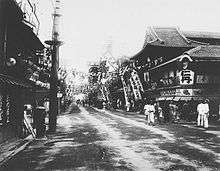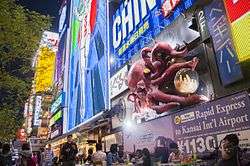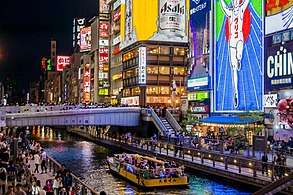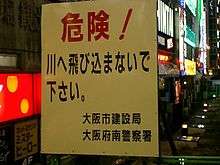Dōtonbori
Dōtonbori or Dōtombori (道頓堀, pronounced [doːtomboɾi]) is one of the principal tourist destinations in Osaka, Japan, running along the Dōtonbori canal from Dōtonboribashi Bridge to Nipponbashi Bridge in the Namba district of the city's Chuo ward. Historically a theater district, it is now a popular nightlife and entertainment area characterized by its eccentric atmosphere and large illuminated signboards.
Dōtonbori 道頓堀 | |
|---|---|
Area | |
 Illuminated signboards at Ebisu Bridge on the Dōtonbori Canal | |
| Country | Japan |
| City | Osaka |
| Founded by | Yasui Dōton |
One of the area's most prominent features, a billboard for confectionery company Glico displaying the image of a runner crossing a finishing line, is seen as an icon of Osaka within Japan.
History

Dōtonbori traces its history back to 1612, when a local entrepreneur, Yasui Dōton, began expanding the tiny Umezu River, which ran east to west, hoping to increase commerce in the region by connecting the two branches of the Yokobori River, which ran north to south, with a canal. Dōton's project was interrupted when he died defending Toyotomi Hideyori in the ill-fated Siege of Osaka, but his cousins finished the canal in 1615. The new lord of Osaka Castle, Tadaki Matsudaira, named the canal and avenue beside it Dōtonbori ("bori" from "hori", meaning "canal"), even though Doton had been on the losing side during the siege.
The character of Dōtonbori became defined in 1621 when the Tokugawa Shogunate instituted urban planning, designating Dōtonbori as the entertainment district of Osaka. By 1662 the avenue boasted six Kabuki theatres and five Bunraku theatres, as well as the unique Takeda Karakuri mechanical puppet theatre. Many restaurants and cafes were built to cater to the flood of tourists and entertainment-seekers pouring nightly into Dōtonbori.
Over the years, declining interest in traditional forms of entertainment led to the closing of most of Dōtonbori's original attractions. Its five remaining theatres were bombed and destroyed during World War II.
Restaurants

Osaka is a major destination for tourists, both domestic and international. The Dotonbori district is a popular area for visitors to the city and boasts a number of well known restaurants offering a range of traditional and modern Japanese dishes.
Kuidaore
Kuidaore (食い倒れ) is a Japanese word meaning roughly “to ruin oneself by extravagance in food.” It is sometimes romanised as cuidaore, and is part of a larger proverb: "Dress into ruin in Kyoto, eat into ruin in Osaka" (京都の着倒れ、大阪の食い倒れ).
The word is associated with Dōtonbori, and is often used in tourist guides and advertisements. It can be seen in the names of several locations in Dōtonbori, such as the mascot Kuidaore Taro and the defunct restaurant Cui-daore.
Some foods associated specifically with Osaka and kuidaore include okonomiyaki, takoyaki, and kitsune udon.[1]
Restaurants of note
- Kinryu Ramen: There are three Kinryu (Golden Dragon) Ramen restaurants in Dōtonbori, one at each end of the street and one in the middle. The chain is notable for its giant three-dimensional golden dragon billboards, as well as its outdoor seating consisting of tatami mats. Unlike many Japanese restaurants, Kinryu Ramen is open 24 hours, and offers a free garlic and kimchi bar.
- Kani Doraku: A crab restaurant, famous for by its moving crab billboard.
- Otakoya: A popular takoyaki stand.
- Zubora-ya: A fugu restaurant with a huge blowfish lantern hanging out front.
- Dōtonbori Ramen Taishokudo: A ramen restaurant formed by eight famous ramen shops from across Japan.
- Hariju: A beef restaurant since 1924.They use only Japanese beef. One of the more famous beef restaurants.
- Imai: An Udon restaurant since 1946. The place used to be a music instrument store before World War II.
- Cui-daore, a massive eight-story restaurant with a different Osaka cuisine on each floor, was a self-proclaimed contender for the title of the world's largest restaurant. However, it ceased operations and closed on 8 July 2008.[2][3]
Landmarks
- Glico Man: Originally installed in 1935, the sign depicting a giant athlete on a blue track is a symbol of Glico candy. The sign has been altered on several occasions to celebrate events such as the World Cup and to show support for the Osaka baseball team, the Hanshin Tigers. The current version is the sixth, which uses LEDs. The previous five incarnations of the sign used neon lights.[4]
- Kuidaore Taro: In front of Cui-daore is a mechanical drum-playing clown, also known as the Kuidaore Ningyo, installed in 1950. Every March the visiting rikishi for the Osaka Grand Sumo tournament used to line up with Kuidaore Taro for photos. Now that the restaurant has closed, Kuidaore Taro has been moved to a new location slightly east of his old haunt.
- Kani Dōraku crab: This six and a half meter crab is on the front of the crab restaurant Kani Dōraku. It is mechanised, being able to move its arms and eyestalks. Built in 1960, this mechanical billboard soon spawned imitations, including a squid that puffs steam and oni (demons) that light up at night.
 Kuidaore Taro
Kuidaore Taro Kani Dōraku crab
Kani Dōraku crab Blowfish lantern of Zubora-ya
Blowfish lantern of Zubora-ya- Glico Man sign
 Shin sai bashi-suji shop complex
Shin sai bashi-suji shop complex
Bridges
(Note: '-bashi' is the Japanese suffix for 'bridge.')
Motor vehicles cross the canal by way of either Dōtonboribashi (part of Midosuji Avenue) on one side or Nipponbashi (part of Sakaisuji Avenue) on the other, flanking the west and east of the main Dōtonbori district. In between are several footbridges connecting the Namba and Shinsaibashi shopping districts to Dōtonbori, such as Tazaemonbashi and Aiaibashi.
Ebisubashi


Ebisubashi is just under the Glico Man billboard. Originally constructed to provide access to the nearby Ebisu Shrine, the bridge is the location of a legendary curse on Osaka's baseball team, the Hanshin Tigers. More practically, the bridge provides a link between the Shinsaibashi-suji and Ebisubashi-suji shopping districts.
Due to the familiarity of the Glico Man, Ebisubashi makes for a convenient gathering point, hence its nicknames, nanpa-bashi, mostly used by foreigners, and hikkake-bashi ("the pulling bridge"), mostly used by native Japanese.
See also
Notes
- Takao Sugiura "Kuidaore: To eat oneself bankrupt A study of Osaka epicurism", Tsuji Group
- "道頓堀「くいだおれ」7月に閉店へ 定年迎え役目終えた". Asahi Shimbun. 2007-04-08. Archived from the original on April 18, 2008. Retrieved 2007-04-10.
- "大阪名物くいだおれ:ミナミの老舗料理店、7月閉店 「時代の変化」理由に". Mainichi Shimbun. 2007-04-09. Archived from the original on April 14, 2008. Retrieved 2007-04-10.
- Glico's landmark Osaka running man to convert from neon to LEDs Archived 2014-06-14 at the Wayback Machine Asahi Shimbun Retrieved October 25, 2015
References
- Davisson, Zack, Osaka InfoGuide, Japan, Carter Witt Media, 2006 (English language tourist guide. Pg. 20-23 have detailed article on Dōtonbori, including history and culture. The majority of this article comes from this tourist guide.)
- Kinoshita, June, Gateway to Japan, USA, Kodansha International, 1998, ISBN 4-7700-2018-X (pg. 608–609, Short section on areas of interest in Namba district)
- Brand New Osaka (2005) "History of Dotonbori". (Short section on the history of Doton Yasui.)link
- Japan National Tourist Association "Dotonbori" . (About the culture of Dōtonbori)link
- Seattle Times (30 November 2005) "10 great moments in baseball superstition history".link (#6 is the Curse of the Colonel)
- AP Worldstream (18 September 2003) "Japanese man drowns during baseball pennant celebrations".link (News article on the death of Masaya Shitababa)
External links
| Wikimedia Commons has media related to Dōtonbori. |
- Dotonbori Street "Virtual Tourist"
- Dotonbori Shopkeepers, "This is DOHTONBORI"
34°40′07″N 135°28′50″E Mouth of Dōtonbori canal 34°40′07″N 135°30′05″E Ebisubashi-Minamidume Intersection